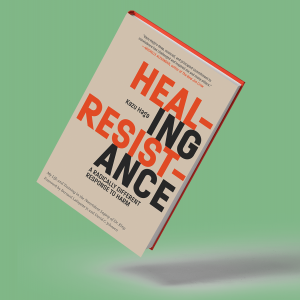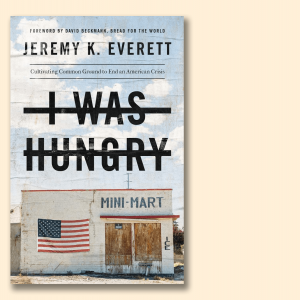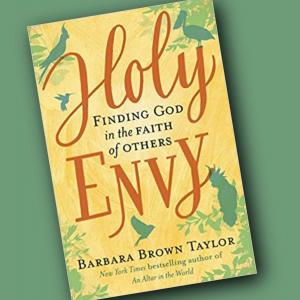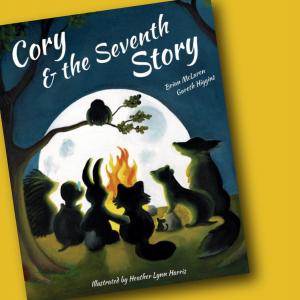
Jon Little is a freelance writer based in Wellington, New Zealand.
Posts By This Author
Nonviolence Reaches Further Than Politics
It's both a philosophy and a toolkit.
NONVIOLENCE. WHEN YOU hear the term, what do you think? In your mind’s eye, what do you see? Black and white newsreels of college students dressed in their Sunday best, picketing segregated businesses? Perhaps you imagine Gandhi’s historic salt march to the sea or Martin Luther King Jr. leading the faithful onto the Edmund Pettus Bridge in Selma.
It’s not uncommon to hear “nonviolence” and think “protest.” There is much value in this association. History demonstrates that nonviolence can be an effective tactic for promoting political change. But in Healing Resistance: A Radically Different Response to Harm, Kazu Haga shows us that it can be much more than a political tool.
Haga—a nonviolence trainer and founder of East Point Peace Academy in Oakland, Calif.—was influenced by the Kingian nonviolence principles and curriculum of Bernard LaFayette Jr. and David C. Jehnsen (who co-wrote this book’s foreword). Haga weaves these principles with lessons from Buddhism, social justice activism, and trauma work, illustrating how we might embrace nonviolence to transform both ourselves and our world.
Reveling in Cans of Anchovies and Hummingbirds
A review of ‘One Long River of Song: Notes on Wonder,’ by Brian Doyle.
“QUIET MIRACLES,” THAT’S what the late writer Brian Doyle calls them, those moments of wonder so freighted with significance they inscribe themselves upon our hearts. If there is a unifying thread in One Long River of Song, a posthumous collection of Doyle’s essays and prose poetry, it is this: Quiet miracles bespot our lives. They are everywhere, if only we have the patience and humility to see them as such.
Consider a shrew or a hummingbird or a can of anchovies clutched to a young boy’s sleeping chest. That’s what Doyle does. He finds miracle and mystery enough to still your heart, bring you to tears, or leave you smirking and smiling in awe. Revealing and reveling in such wonders is what Doyle does best. And he does it time and time again, in short prose poems and essays that rarely run over two pages long.
Will Churches Make Room for #MeToo?
A review of “The #MeToo Reckoning,” by Ruth Everhart.
“O LORD, HOW long shall I cry for help, and you will not listen?” (Habakkuk 1:2). Ruth Everhart opens her heart-wrenching new book, The #MeToo Reckoning, with this lamentation. In a nation where, according to the Centers for Disease Control and Prevention, more than one in three women are sexually assaulted in their lifetime, lamentation and tears seem a fitting place to start. But Everhart reminds us that to lament is not merely to cry out in anguish. To lament is also to bring pain to light, to air wrongs suffered, and, in the same impassioned breath, to call for justice.
It is this more fulsome form of lamentation that frames Everhart’s book and undergirds her prophetic pronouncement against churches, calling on them to become braver and safer spaces, spaces more protective of the vulnerable, more supportive of victims and survivors, and more committed to seeking justice on their behalf.
Throughout The #MeToo Reckoning, Everhart, a Presbyterian pastor, recounts the incidents of sexual assault that she and others suffered and survived. From being raped inside a church to being assaulted by an elder on an overnight youth trip, these stories make for difficult reading. But they are important reading. Until we face the reality and extent of sexual assault, we will neither be able to properly support its victims nor bring this predatory behavior to an end.
You Can’t End Hunger By Yourself
A review of “I Was Hungry: Cultivating Common Ground to End an American Crisis,” by Jeremy K. Everett.
IF ALL THE hungry people in the U.S. were gathered into one state, its population would roughly match that of California. According to the USDA, 40 million Americans are food insecure. This means 1 in 8 Americans lack sufficient food to live a healthy life.
Our children fare even worse. In the richest nation the world has ever known, 1 in 6 children will at some point this year be left with a growling belly, wondering where their next meal is coming from, and when. In South Texas, where Jeremy Everett works to end hunger, 1 in 2 children face such dire straits.
According to Everett, to tackle a problem as large and complex as hunger, individual trust, commitment, and community buy-in are crucial. They are not enough, though: Widespread collaboration is also required. Communities must join forces with other communities, nongovernmental organizations, businesses, and government at all levels. They must pool their resources and knowledge and coordinate their efforts.
Richard Rohr Sees the Divine Image in Everything
A review of "The Universal Christ: How a Forgotten Reality Can Change Everything We See, Hope For, and Believe," by Richard Rohr.
WISDOM RARELY SURPRISES. More rarely does it shock or scandalize. Yet, with The Universal Christ, Richard Rohr, the Franciscan priest and founder of the Center for Action and Contemplation, aims to do both.
He starts with the Incarnation. Was it a startling, once-in-eternity event that explains Jesus Christ’s holiness? Rohr suggests instead that the Incarnation is the fundamental pattern for all creation. We live within, and are ourselves a party to, this ongoing incarnation—people, pets, and poppy seeds alike. Nothing lacks the divine impress. In this worldview, “a mature Christian sees Christ in everything and everyone.”
To underscore this view, Rohr provocatively disentangles the modifier “Christ” from “Jesus.” He reserves “Jesus” for Jesus of Nazareth. “Christ” is for the Divine Presence that has existed in all things since creation, both before and after Jesus of Nazareth demonstrated total, unrelenting acceptance of the divine.
A More Mature and Secure Faith
A review of ‘Holy Envy: Finding God in the Faith of Others,’ by Barbara Brown Taylor.
IF WE SEEK more than spiritual security—if we long for more than bobble-headed affirmation of our preconceived beliefs—we must step out of our cloistered faith and engage the strangers all around us. This is the message at the center of spiritual memoirist and best-selling author Barbara Brown Taylor’s Holy Envy: Finding God in the Faith of Others.
After leaving behind her clerical collar and post as an Episcopal priest, Taylor took up the call to teach. For nearly 20 years, she taught introductory classes on world religion at a small college in northern Georgia. Early on, her aims were relatively meager. To introduce her students to a few of the world’s great religions, acquaint them with the diversity of faiths that exist not just across the globe but right across the street—this seemed enough. And so she outlined Buddhism’s eightfold path. She explicated the doctrinal differences between Sunni and Shia Islam and taught her students what exactly made a kosher meal kosher.
It didn’t take Taylor long to realize that though literature and secondhand knowledge can teach much, it is through direct interaction with people of other faiths that we learn the most about their faiths and our own. When Taylor stepped out from behind the lectern and took her students on field trips to masjids (mosques) and temples, she learned that her view of God and faith was partial. On these trips, she often found her faith tested and was, on more than one occasion, totally smitten.
The Stories that Unite Us
A review of ‘The Seventh Story: Us, Them, and the End of Violence’ (e-book) and ‘Cory and the Seventh Story,’ by Gareth Higgins and Brian D. McLaren (illustrated by Heather Lynn Harris).
STORIES ARE more than mere entertainment: They rest at the heart of who we are. They shape our understanding of the world and how we choose to live in it, both individually and collectively. They can sever us from one another or call us into deeper communion. This is the message at the center of two new books by Gareth Higgins (a Sojourners columnist) and Brian D. McLaren (a Sojourners contributing editor).
In The Seventh Story: Us, Them, and the End of Violence, Higgins and McLaren suggest that the violence and division that is part of our past and present are neither inevitable nor coincidental. They’re part and parcel of the stories we live by. The authors highlight six story types that are particularly pernicious and all too common: stories of domination, revenge, escapist isolationism, scapegoating, acquisition, and victimization.
Drawing on what theologian Walter Wink calls “the myth of redemptive violence,” Higgins looks at the role these story types play in justifying and perpetuating violence. He reminds us that, as was the case in his native Ireland, it is the work of peace and reconciliation—not more violence—that is truly redemptive.






